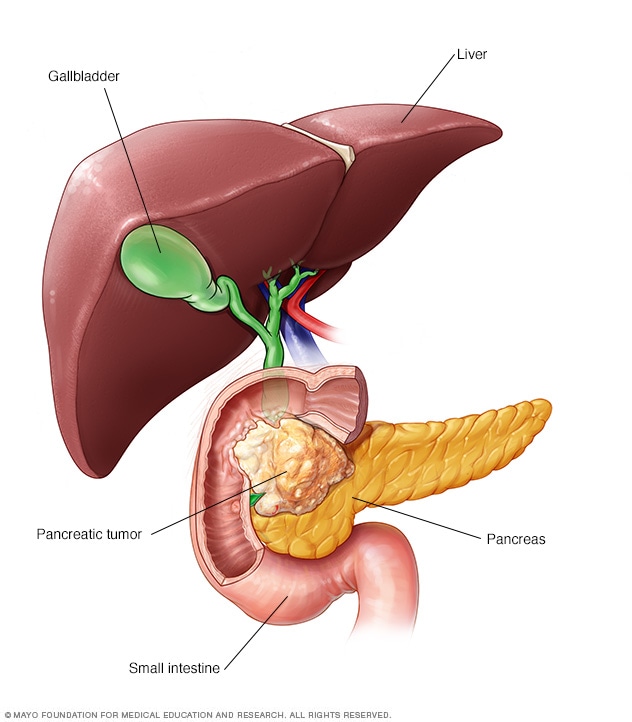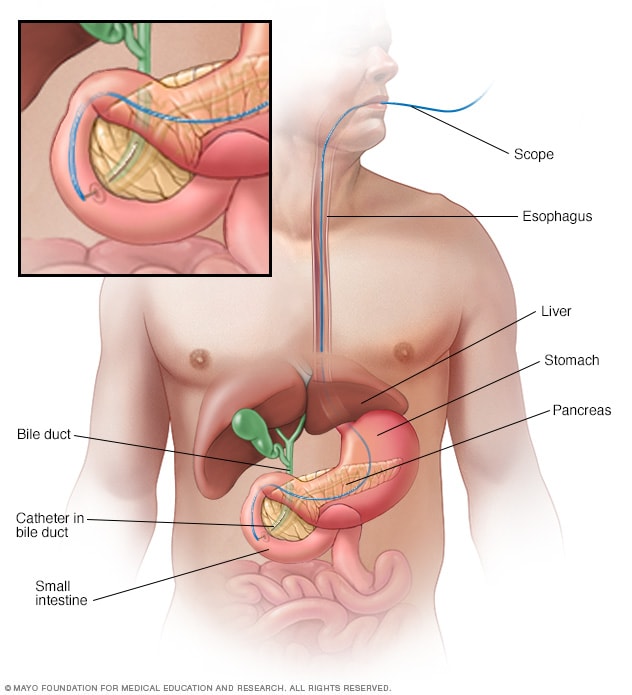
This article was originally published in Mayo Clinic Blog
system
Pancreatic cancer begins in the tissues of your pancreas — an organ in your abdomen that lies behind the lower part of your stomach. Your pancreas releases enzymes that aid digestion and produces hormones that help manage your blood sugar.
Several types of growths can occur in the pancreas, including cancerous and noncancerous tumors. The most common type of cancer that forms in the pancreas begins in the cells that line the ducts that carry digestive enzymes out of the pancreas (pancreatic ductal adenocarcinoma).
Pancreatic cancer is seldom detected at its early stages when it’s most curable. This is because it often doesn’t cause symptoms until after it has spread to other organs.
Pancreatic cancer treatment options are chosen based on the extent of the cancer. Options may include surgery, chemotherapy, radiation therapy or a combination of these.
Signs and symptoms of pancreatic cancer often don’t occur until the disease is advanced. They may include:
See your doctor if you experience any unexplained symptoms that worry you. Many other conditions can cause these symptoms, so your doctor may check for these conditions as well as for pancreatic cancer.
It’s not clear what causes pancreatic cancer. Doctors have identified some factors that may increase the risk of this type of cancer, including smoking and having certain inherited gene mutations.
Your pancreas is about 6 inches (15 centimeters) long right beneath your left side diaphragm and looks something like a pear lying on its side. It releases (secretes) hormones, including insulin, to help your body process sugar in the foods you eat. And it produces digestive juices to help your body digest food and absorb nutrients.
When you consume processed foods or foods without enzymes, the pancreas works harder than normal to produce more enzymes. A high-carbohydrates diet irritates the pancreas and increases the risk of pancreatic cancer. High carbohydrates create a lot of oxidation in the pancreas and spike triglycerides.
Pancreatic cancer occurs when cells in your pancreas develop changes (mutations) in their DNA. A cell’s DNA contains the instructions that tell a cell what to do. These mutations tell the cells to grow uncontrollably and to continue living after normal cells would die. These accumulating cells can form a tumor. When left untreated, the pancreatic cancer cells can spread to nearby organs and blood vessels and to distant parts of the body.
Most pancreatic cancer begins in the cells that line the ducts of the pancreas. This type of cancer is called pancreatic adenocarcinoma or pancreatic exocrine cancer. Less frequently, cancer can form in the hormone-producing cells or the neuroendocrine cells of the pancreas. These types of cancer are called pancreatic neuroendocrine tumors, islet cell tumors or pancreatic endocrine cancer.
Factors that may increase your risk of pancreatic cancer include:
A large study demonstrated that the combination of smoking, long-standing diabetes and a poor diet increases the risk of pancreatic cancer beyond the risk of any one of these factors alone.
It is the dosage of exposure that determines the poison, says Dr. Berg. The key to cancer is chronic exposure to certain things that can create inflammation and dysfunction in certain parts of your cell called mitochondria. Mitochondrion is the energy factory of your cells that uses oxygen to help burn fuel; however, with cancer, that mechanism is destroyed. Then you have the backup system that used to keep things alive, and that system is called fermentation.
So when this happens, cancer becomes out of control. The chronic exposure can be
 Endoscopic retrograde cholangiopancreatography (ERCP) open the pop-up dialog box.
Endoscopic retrograde cholangiopancreatography (ERCP) open the pop-up dialog box.
As pancreatic cancer progresses, it can cause complications such as:
You may reduce your risk of pancreatic cancer if you:
Consider meeting with a genetic counselor if you have a family history of pancreatic cancer. He or she can review your family health history with you and determine whether you might benefit from a genetic test to understand your risk of pancreatic cancer or other cancers.
There is a therapy option for cancer called insulin potentiation therapy; IPT is done with an injection of insulin, which brings your blood sugar down, while at the same time you are giving a small dosage of chemotherapy. So when the insulin goes up and the blood sugar goes down, the cancer cells will get hungry and start going after the sugar in the body. But if you add a small amount of sugar to the chemo, they will attract the cancer cells, with that, will be killed off, and other healthy cells will not be affected. However, if you choose chemotherapy as a means of cancer treatment, here are some things you need to know.
Chemotherapy does not differentiate cancer cells from normal, healthy cells in your body, it destroys them both. It creates significant side effects that sometimes are worse than cancer itself, and it weakens the immune system, causing cancer to come back. The side effects are:
Cancer lives on sugar and glutamate (amino acid). If going on chemotherapy, reduce your consumption of carbohydrate and sugar, and also reduce the amount of glutamate you consume. Glutamate is in certain foods but not in fatty foods, so many people will increase the amount of healthy fat with a smaller amount of protein (like amino acid powder).
You can also starve off cancer by going on a healthy keto diet, where you reduce the amount of carbohydrate you consume.
Intermittent fasting reduces the amount of glutamate in the body, which is the food for cancer. The cancer cells mostly spread to areas of the body with inflammation. If you can slow down inflammation, that will help slow down the spread of the cancer. You can slow down inflammation by taking a high amount of vitamin D while intermittently fasting.
The most effective chemoprotective agent is polyphenol. Polyphenol is a plant based chemical called EGCG (Epigallocatechin Gallate). This EGCG can be found in green tea; it has potential as a protective factor against chemicals.
Taking green tea will not minimise the effect of chemo; you have to include, chlorophyll (wheat grass juice power) and cruciferous vegetables.
Telemedicine offers you the opportunity to access medical services from healthcare professionals at your own convenience and from the comfort of your home. It is one of the interventions that emerged in the medical section with the onset of technology to reach out to individuals irrespective of their location.
It is good to live a healthy lifestyle; however, you also need to communicate with healthcare professionals once or twice a year to ensure your biomarkers are fine. Telemedicine gives a platform to access services without much discomfort. Consult a doctor today through your telecommunication device.
1. What do I need to know about pancreatic cancer?
Usually, the pancreatic ducts are where pancreatic cancer begins. Tumors are groups of cells that proliferate uncontrollably due to slight alterations in the cellular DNA. These cancer cells have the ability to travel outside of the pancreas and into other body organs if left untreated.
2. What is the best thing for pancreatic cancer?
Though not everyone has the option, surgery is a viable treatment for pancreatic cancer. Cancer that hasn’t spread to other organs may be treated with it. In the event that the malignancy becomes large or invades adjacent blood vessels, surgery may not be feasible. Chemotherapy is one of the alternative treatments that may be used initially in these cases.
3. What usually kills a person with pancreatic cancer?
What ultimately results in the death of the majority of pancreatic cancer patients, if a person may survive without a completely functional pancreas? The majority of pancreatic cancer patients pass away from liver failure as a result of the tumor taking over their liver.
4. What not to eat when you have pancreatic cancer?
Cut back on extra sugar and sweets. People who have pancreatic cancer frequently experience difficulty breaking down sugar-rich diets. Foods that frequently don’t have any nutritional value, such as soda, cake, candies, and desserts, might raise blood sugar levels. Steer clear of these items and swap them out with nutritious ones.
5. What are 10 amazing foods to heal your pancreas?
Foods to include in a pancreatitis diet are:
6. How to take care of a patient with pancreatic cancer?
Looking after a family member who has pancreatic cancer can be challenging. Here is how you can take care of a person with pancreatic cancer:
Brennan, D., & Kumar, K. (2024). What foods should you eat while recovering from pancreatitis?
Dr Berg, E. (2020). How to reduce the side effects of chemotherapy.
Mayo Clinic. (2023). Pancreatic cancer.
Moyer, M. W. (2011) Why is pancreatic cancer so deadly?
Walsh, C. M. (n.d). Pancreatic cancer nutrition: 12 pancreatic diet tips.
FeaturedNovember 16, 2023
Health and Safety November 30, 2020
FeaturedSeptember 3, 2020
NutritionOctober 30, 2020
Health and Safety November 30, 2020
NutritionFebruary 5, 2025
MedicationFebruary 5, 2025








